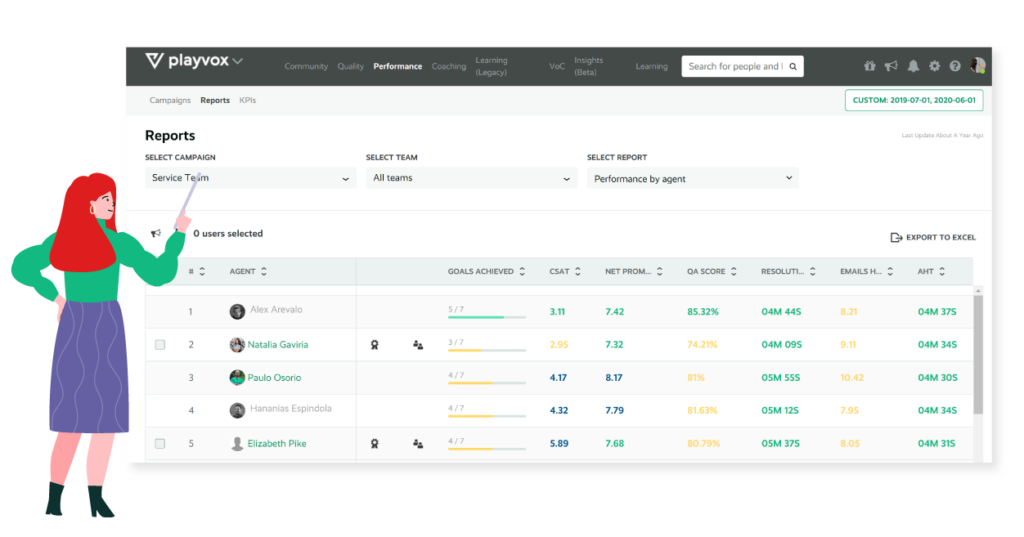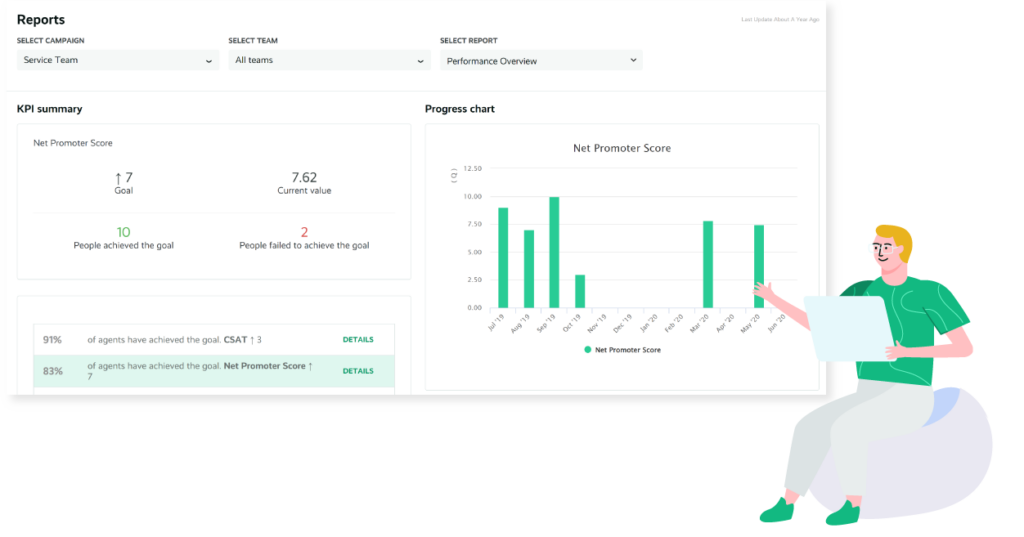What You Need To Know About The Best Performance Dashboards
It is said that you can’t manage what you cannot measure. Monitoring and tracking performance metrics is much easier with the right tools. Contact centers and customer service departments that still depend on cluttered spreadsheets for managing performance reports are only making their work harder.
Modern solutions allow for much easier, more streamlined performance management. And a huge part of that begins with equipping your contact center with the right dashboards.
Having fast access to key business performance metrics and dynamic reports cultivates a more effective performance campaign, eliminating the confusion or oversights that outdated practices can cause. But what are the advantages of performance dashboards and what are the must-have features?

What Is A High-Quality Performance Dashboard?
First things first: let’s define the dashboard. A high-quality performance dashboard is used to view information in a clear, organized way, covering different aspects of your business. This may include information on business unit performance measures across all departments, customer experience, training, and much more.
A good dashboard makes it easy for managers, team leaders, and customer service representatives to view data relevant to their own work. Graphics, metrics, and different types of static performance reports should all be available, just by clicking from one tab to the next.
Ideally, your performance dashboard will pull information from many separate tools to be viewed without actually needing to visit them. Logging into multiple platforms to review different kinds of data can be time-consuming, disrupting productivity and causing confusion.
Playvox WEM software, for example, can be integrated with multiple CRM tools, including Salesforce and Zendesk. Data is centralized and available in your dashboard, collating information from each contact center source, creating a streamlined process.
What Are The Different Types of Performance Dashboards?
The best performance dashboards can be customized to suit your business needs and user preferences. It should be easy to arrange and manage, enabling anyone — regardless of their tech experience — to use it with ease. As a result, reviewing actual performance and managing these important metrics becomes far easier.
Several types of dashboards are useful for your contact center leaders to improve your bottom line:
- Sales performance dashboard
- Employee performance dashboard
- Financial dashboard
- Company performance dashboard
- Product performance dashboard
- Agent performance dashboard
Each of these powerful tools can provide real-time data and actionable insights that will allow contact center managers to solve key issues and improve the overall business strategy.
Related Article: 5 Top Metrics for Your Customer Service Team Dashboard
What Should A Good Performance Dashboard Include?
The best performance tools offer employees at different levels of a business their own dashboard, providing them with the data they depend on every day without having to wade through pages of irrelevant information.
Agents, team leaders, managers, quality analysts, and admins should all have access to their own dashboards, customized to their specific roles. For example, an agent’s dashboard will include unique features that aren’t as relevant to an admin or manager.
For example, one key element of Playvox QM software is motivation. Agents are assigned points when they complete a certain goal or when a manager wants to recognize their achievements. Points show the agent’s colleagues how well they’re doing and can inspire others to develop their skills, cultivating a sense of healthy competition in teams.
Agents can view points and redeem them in a store, in exchange for rewards determined by managers or admins. Having access to their points is a great motivator for agents, showing them their current status and how far they have to go until they can afford to unlock a reward they want.
This has the power to boost engagement significantly, which is fantastic when you remember that engaged employees are more productive than others.
But managers’ dashboards, on the other hand, don’t display their own points because they are not as relevant to the work they provide. They have their own targets to work toward, but the element of gamification isn’t necessary to motivate them.
Instead, a manager’s dashboard will display visual insights, marketing campaigns, human resource tools, customer satisfaction ratings, operational costs, profit margin percentage, conversion rates, and more. With this level of insight, managers will have a better understanding of the key issues needing to be addressed and the impact on larger strategic goals.
A good dashboard should provide interactive tools to manage teams and users easily, with restricted access to certain types of information or actions. Providing everyone with full rights to make changes, assign tasks, and have access to all performance measurement systems documents with easily accessible tools could be a formula for disaster.
Performance dashboards must be set up to equip employees at different levels with the resources they need, yet prevent them from getting involved in the advanced features they shouldn’t have access to.

The Importance Of Real-Time Data In Performance Dashboards
A contact center performance dashboard must present real-time data relevant to the agent, manager, or analyst using it. Without it, no one can make the crucial adjustments needed to deliver an exceptional customer experience.
Real-time data about performance is vital to your contact center operations because if you’re acting on outdated data — even a few days old — you can’t make accurate decisions.
With real-time data about performance, a manager can uncover issues with agents faster. For instance, if an agent is struggling to keep up with the required number of concurrent chats, their manager should take quick action. With real-time performance data, they can spot the issue as it’s happening and move the agent to a channel where they’ll be more successful or provide coaching to improve performance.
Related Article: 5 Benefits Of Providing Omnichannel Customer Service in The Call Center
Reviewing Primary Metrics And Making Informed Decisions
Performance dashboards should be calibrated to give employees visibility. Admins, team leaders, and managers, for example, can benefit greatly from simple graphics visualizing agents’ or analysts’ progress on certain tasks. These can be customized with different colors to convey the required information in a style suiting users’ needs.
They will be able to determine whether workers are on target to hit deadlines or if they’re likely to miss them. At a glance, they can decide whether to extend the time period or address the issue with the employee.

Quality analysts, on the other hand, rely on having access to key metrics pulled from across various integrated tools. They should be able to filter metrics by type, dates, importance, and more, and compare them with older or different metrics. Tracking agents’ growth is far easier with such features, giving analysts, team leaders, managers, and admins more time for higher-value tasks and projects.
These metrics can be used to generate reports to be shared with colleagues, updating the right people on the performance campaign in just a few short steps. Performance dashboards aid decision-making by collating information and showing where problems lie and allowing managers to correct poor performance. Files may be uploaded to the dashboard for future reference or sharing data with others too, without the need to send emails — everything’s contained to one platform.
Being able to view performance data and graphics means all decisions are based on data reducing the element of risk significantly. Everyone in the business is on the same page, and all goals are aligned to ensure employees understand what’s expected of them. There’s less confusion about where best to direct their skills and fewer mistakes.
Related Article: 14 Tips to Align Call Center Agents With Your Operational Goals
Implementing High-Quality Performance Dashboard Solutions
Launching a performance program is vital for detecting problems and taking action to correct them. But the right tools are essential to maximizing efficiency and impact. Relying on outdated or poorly designed visualization tools to manage your team only makes the entire process harder than it should be.
Taking the time to calibrate your performance dashboard will pay off when employees work in harmony. Focusing on the features and functions explored above will help you maintain performance dashboards that streamline your program, keep workers at all levels organized, and reduce the risk of oversights.
For more information about interactive features, real-time analytics, aggregate performance, and more, schedule a demo with Playvox to learn more.







